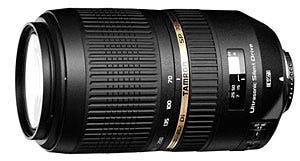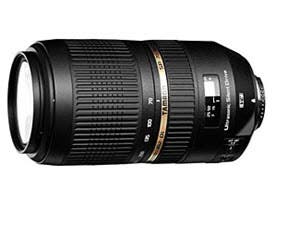March 9, 2010, Commack, NY— President and CEO Morio Ono of optical equipment manufacturer Tamron Co., Ltd., announced another advance in Tamron’s pursuit of high resolution images in the telephoto lens category with the development of a 70-300mm F/4-5.6 telephoto zoom lens featuring image stabilization––VC (Vibration Compensation) and an ultrasonic auto-focus drive –– USD (Ultrasonic Silent Drive). The SP AF70-300mm F4-5.6 Di VC USD (Model A005) high-resolution DSLR telephoto zoom lens has been produced first for the Nikon mount, with the development of compatible mounts for Canon and Sony to follow. This new telephoto zoom lens is designed for digital SLR cameras and can be used with both full-frame sensor as well as AF 35mm film cameras with a zoom range of 70-300mm; and with APS-C sensor cameras where the angle of view will change the zoom range equal to 109-465mm .
This new telephoto zoom lens is designed for digital SLR cameras and can be used with both full-frame sensor as well as AF 35mm film cameras with a zoom range of 70-300mm; and with APS-C sensor cameras where the angle of view will change the zoom range equal to 109-465mm .
With superior optical performance, Tamron’s own USD (Ultrasonic Silent Drive) and VC (Vibration Compensation), the SP 70-300mm F4-5.6 Di VC USD (Model A005) provides the performance of a high-end premium telephoto zoom that is appealing to a broad spectrum of photography enthusiasts.?????????????????????????????????????????????????????
Unparalleled optical performance in a fast and steady telephoto zoom lens
In the pursuit to achieve the most outstanding image resolution in the 70-300mm class, Tamron’s 60th Anniversary lens – the SP AF70-300mm F4-5.6 Di VC USD (Model A005) – utilizes an advanced optical design that features an LD (Low Dispersion) and an XLD (Extra Low Dispersion) lens element made from specialized materials that prevent chromatic aberration. As a result, the SP AF70-300mm Di VC USD boasts sharper contrast and greater descriptive performance than all others in its class.
In addition, it is the first Tamron lens sporting a USD (Ultrasonic Silent Drive), Tamron’s very own ultrasonic auto-focus drive mechanism. This USD mechanism delivers fast focusing, making it a perfect telephoto zoom choice for photographing sports, racing, and other fast-moving subjects. The lens also boasts Tamron’s proprietary VC (Vibration Compensation) image stabilization to assist in hand-held shooting, not only at long focal length ranges where blurring is common, but also under low-lit conditions, dramatically enhancing photographic freedom.
This combination of best in class image resolution, Ultrasonic Silent Drive and Vibration Compensation is a new achievement of Tamron technology, culminating in the production of a premium 70-300mm telephoto zoom lens.
Product Features
? New optical system optimized for digital cameras achieves top resolution in the 70-300mm class with specialized glass elements including an XLD (Extra Low Dispersion) lens element This lens’ advanced optical design employs a sophisticated XLD (Extra Low Dispersion) lens element made from specialized high-grade glass that has lower dispersive properties than standard LD lenses (where refraction causes the dispersion of white light into spectral hues). The dispersive properties of the XLD lens are at a level similar to fluorite, and in combination with LD elements make for an optimal optical design that delivers best in class resolution with advanced axial chromatic and magnification aberration correction – major inhibitors of image quality enhancement. The result is a lens that delivers sharp contrast and better descriptive performance throughout the entire zoom range.
? Fast focusing with USD (Ultrasonic Silent Drive), Tamron’s ultrasonic autofocus drive The lens is equipped with Tamron’s first-ever ultrasonic auto-focus drive USD (Ultrasonic Silent Drive). It achieves faster focusing making this telephoto lens perfect for photography of sports, motor racing, and other fast-moving subjects. With advanced motor technology and newly developed software, Tamron’s USD delivers precise and noiseless focusing at turbo speed.
? USD (Ultrasonic Silent Drive)
Tamron’s USD works with the high-frequency ultrasonic vibrations that are produced by a ring called a ‘stator’. Energy from the vibrations is used to rotate an attached metallic ring known as the ‘rotor’. Piezoelectric ceramic, an element that produces ultrasonic vibrations when voltage of a specific frequency is applied is arranged in a ring formation on the stator. This electrode configuration of piezoelectric ceramic causes two ultrasonic vibrations to occur in the stator.
By effectively combining these two ultrasonic vibrations, it is possible to convert the energy from the vibrations that produced simple motion into energy known as ‘deflective traveling waves’, which then moves around the circumference (rotation direction) of the ring.
With the USD, the friction between these deflective traveling waves created on the metallic surface of the stator and the surface of the rotor produce force, causing the rotor to rotate. The focusing ring lens, which is linked to the rotor, is thus moved, creating a fast and smooth auto-focus drive.
The above is an unedited press release provided by Tamron Co. Ltd.



